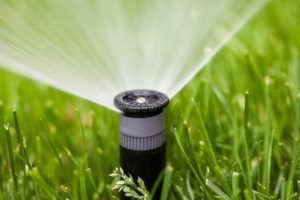Lawn irrigation and lawn sprinklers have come a long way over the years with the advent of the fixed head sprayers. Larger grass fields like parks and baseball fields still require larger spray heads, but the typical residential lawn can be irrigated more efficiently with smaller sprinkler heads.
Details Landscape Art, a Sonoma County landscape contractor, will first add soil amendments to and then rototill the lawn area thoroughly; lawn edging defines the outline of the new lawn.
The irrigation system begins with the installation of the valve near a water source. Multiple valves may be required, depending on the number of spray heads to be installed and the available water volume and pressure.
Proper spacing of the lawn sprinklers is critical. They spray a given distance, which can be controlled by the size of the nozzle installed in each head. They may throw six feet, eight feet, ten feet, twelve feet, fifteen feet, etc. Sprinkler heads, as a general rule however, do not do a good job of watering close to themselves, so we make sure that each head sprays far enough to reach the adjacent heads. This is called ‘head to head coverage’.
Nozzles are also available in different spray patterns – full circle, three quarters, half, quarter, etc. When installing a curvilinear lawn, the most effective nozzle is a variable arc nozzle or VAN. This nozzle’s spray pattern can be adjusted to whatever is required by the curve of the lawn.
Once the head locations are designed and marked with flags, trenches are dug to a depth of about six to eight inches, and a network of Schedule 40 PVC pipe is run from the valve to the various heads. Schedule 40 is a thicker walled pipe, and is the only pipe we use. Many contractors use Class 200 pipe, a thinner walled pipe, which saves a few pennies, but is brittle, weaker and susceptible to breaking. If there are going to be twelve heads, we would divide them into two lines of six each, and connect each line to its own valve. A ‘swing joint’ is attached between the end of the pipe and the sprinkler head, with fittings called Marlex street ells, which allows the head some movement in all directions so it doesn’t break if hit with something such as a lawnmower. Nozzles are then installed and adjusted and the whole system is tested to ensure that the lawn area is adequately covered. If all is OK, the trenches are backfilled, and the lawn is ready to be installed.
An important part of the sprinkler system is the irrigation controller. Each valve has what’s called a solenoid, which is the electrical part of the valve, and allows the valve to be wired to the controller. The controller is programmed to electronically operate the valve for a specified number of minutes, on specified days of the week or ate specified intervals, and at a specified time of day. This allows the homeowner the peace of mind to know that his lawn sprinklers will come on automatically as programmed without having to think about it.

